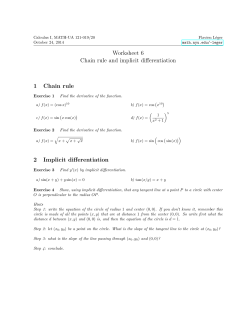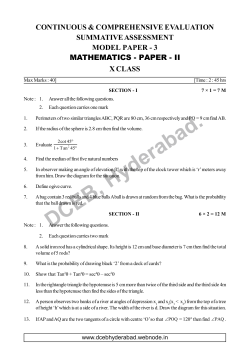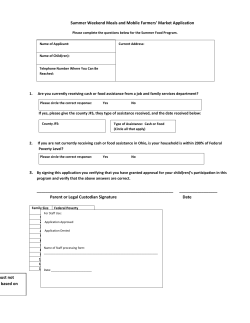
Chapter 1 - Princeton University Press
March 3, 2015 Time: 06:30pm chapter1.tex © Copyright, Princeton University Press. No part of this book may be distributed, posted, or reproduced in any form by digital or mechanical means without prior written permission of the publisher. Chapter 1 Going in Circles Question: How do you make a circle (and other curves)? The ancients knew how to make a circle using a compass or its equivalent. I like to imagine an early genius tying a piece of charcoal to one end of a string of plant fiber and drawing the charcoal along a flat rock face while holding the other end of the string fixed. You can still do that, but suppose that we want to enjoy modern technology and draw a circle on a computer screen—a problem not faced in antiquity. How do we make a circle? If you ask most people for the equation of a circle, you will probably hear 𝑥2 + 𝑦2 = 1 or perhaps (𝑥 − ℎ)2 + (𝑦 − 𝑘)2 = 𝑅2 for a circle with center (ℎ, 𝑘) and radius 𝑅. This is fine, but it represents a static view of a circle, which is not the simplest way to direct the drawing of one. The simplest way to instruct a machine to draw a circle uses a parametric form, also known as a vector-valued function: 𝛾(𝑡) = (cos(𝑡), sin(𝑡)) for the unit circle and 𝛾(𝑡) = (ℎ + 𝑅 cos(𝑡), 𝑘 + 𝑅 sin(𝑡)) for a more general one. In either case, as the time parameter 𝑡 advances from 0 to 𝜋/2, we climb the upper-left quadrant of the circle in a counterclockwise fashion. It takes 2𝜋 units of time to return to our starting point and complete the drawing. The given formula parametrizes the circle in one particular way. If we need to be more flexible, wanting to specify motion around a circle that starts at a particular point and goes a particular direction, we can tweak the formula, perhaps by swapping the coordinates or introducing minus signs, as in the following example. Example: A Rolling Quarter Place two quarters flat on the table with one above the other, both oriented right side up. If the top one rolls without slipping around the other, find a formula for the motion of the point that was originally at the bottom edge of the top circle. Figure 1.1 shows the configuration before and after the quarter has rolled about 60∘ . We use a letter 𝐹, as well as some dashed construction lines, to help you follow the solution. For general queries, contact webmaster@press.princeton.edu March 3, 2015 Time: 06:30pm chapter1.tex © Copyright, Princeton University Press. No part of this book may be distributed, posted, or reproduced in any form by digital or mechanical means without prior written permission of the publisher. SOLUTION. Suppose the quarter has radius 1 and has rolled so that the arc length rolled out on each quarter is 𝑡. The position of the center of the rolling quarter is then (2 sin(𝑡), 2 cos(𝑡)). This is what we meant by tweaking the formula: When no arc length has been rolled out (𝑡 = 0), this vector should be pointing straight up, and when 𝑡 is small and positive, the 𝑥-value should be increasing. The formula matches. Similarly, it takes a little work to figure out that the position of the rolling point relative to the center of the rolling quarter is (− sin(2𝑡), − cos(2𝑡)). Here are a few steps: In the diagram, the dashed lines might help you locate certain transversals. These are key to showing that the angle up from the vertical is twice the angle 𝑡. Adding the two vector displacements, we find that the desired vector motion is 𝛾(𝑡) = (2 sin(𝑡) − sin(2𝑡), 2 cos(𝑡) − cos(2𝑡)) , drawn on the top in Figure 1.2. BEYOND THE ROLLING QUARTER. The path of the rolling quarter is an example of a curve called an epicyloid, the curve produced by rolling one circle around another. In general, if the fixed circle has radius 𝑎 and the rolling circle has radius 1, the formula for the moving point is Figure 1.1. Top: Initial position of rolling quarter. Bottom: The quarter has rolled a bit and point X has traced some of our curve, as if it dribbled a dot of red ink on each point it passed over. ((𝑎 + 1) sin(𝑡) − sin((𝑎 + 1)𝑡), (𝑎 + 1) cos(𝑡) − cos((𝑎 + 1)𝑡)) . (You may wish to show this as an exercise.) Figure 1.2 shows two examples, the first with both circles the same size and the second with one circle twice as large as the other. Wheels on Wheels on Wheels * EXERCISE 1 2𝜋 Apply the formula 𝐿 = ∫0 |𝛾 (𝑡)|𝑑𝑡 to show that the arc length of the path of the rolling quarter from our first example is 16 units. Let’s think of the epicycloid as representing one particular kind of superposition of circular motions, where we insist that the circles roll without slipping. If we remove that restriction, we open the discussion to any sum of vector functions, each of which represents a circular motion, possibly tweaked to turn a different direction. I call this an instance of “wheels on wheels on wheels.” To create a particular example, I chose some more or less random wheels of different sizes and set them to turn at various rates, adding the vector displacements to form the function 𝜇(𝑡) = (cos(𝑡) + sin(6𝑡) cos(14𝑡) cos(6𝑡) sin(14𝑡) + , sin(𝑡) + + ). 2 3 2 3 The first term in each component is our familiar unit circle; the other terms represent smaller wheels, one turning 6 times as fast, another 14 times as fast and altered somehow (the sine and cosine functions are swapped). The result is rendered in Figure 1.3. Take a moment to trace it with your eye and enjoy its dancing undulations, realizing that probably none of us has the patience to draw it without the aid of technology. For general queries, contact webmaster@press.princeton.edu 2 Chapter 1 March 3, 2015 Time: 06:30pm chapter1.tex © Copyright, Princeton University Press. No part of this book may be distributed, posted, or reproduced in any form by digital or mechanical means without prior written permission of the publisher. I hope that the figure—the “mystery curve”—surprises you. Nothing about the numbers 6 and 14 prepares for the evident rotational symmetry, which means that the figure is unchanged if we rotate it through 72∘ . Our next agenda item is to answer the question: What causes this curve to have 5-fold rotational symmetry? OUR COMPUTATIONAL PARADIGM. The formula for the mystery curve assigns one point of the Cartesian plane to every one of the infinitely many values of the time parameter 𝑡. When I ask a computer to draw the curve, modern software frees me from the need to figure out exactly how to instruct the computer to select a mere finite few time values for which it places blobs of ink on the page or lighted pixels on my screen. The details of computer graphics are lovely but are not the purpose of this book; here, I invite us to be consumers, rather than inventors of computer graphics. In the instance of the mystery curve, a close examination of Figure 1.3 suggests that I could have been a slightly more demanding consumer: At a few places on the curve, I can detect that the machine has approximated the perfectly smooth shape by some line segments. Since I know the curve bends smoothly, I don’t object to this imperfection. I enjoy the availability of technology that can do as well as it did. And if I wanted a finer rendition, I could have instructed the machine to use more points in its drawing routing. From the relatively simply mystery curve to the most complicated color image in this book, the paradigm is the same: We look for mathematical objects, which we will call smooth functions, that have some symmetry that we wish to illustrate, perhaps the rotational symmetry of the mystery curve, perhaps something else. Directing computers to make images of the discovered objects is not really the interesting part of the process; it’s the finding of the class of symmetrical things. This is what creating symmetry means to me: finding the formulas like the one for the mystery curve—with its enigmatic 6 and 14—that will display symmetrical images when rendered by software. It is not so much about the method of computer rendition but the mathematical theory of what makes things dance in the dazzling variety of patterned ways that we see in every tradition of decorative art. Figure 1.2. Two epicycloids: On the top is the locus generated by the point on the rolling quarter; in the bottom epicycloid, the rolling circle has half the radius of the stationary one. Some Ancient Mathematics The trigonometric functions are not the only way to parametrize the circle. There is some evidence that the ancient Babylonians knew a different way. It appears that they knew how to find pairs of rational numbers 𝑥 and 𝑦 that solve the equation 𝑥2 + 𝑦2 = 1, which, when we clear denominators, become what we know as Pythagorean triples. Much has been written about the history of a mysterious tablet called Plimpton 322, which lists, without any commentary that we can understand today, a baffling array of Pythagorean triples [15]. Here we remark only that the vector function 𝛾(𝑡) = ( 2 1−𝑡 2𝑡 , ) 1 + 𝑡2 1 + 𝑡2 Figure 1.3. The mystery curve: What causes its symmetry? (1.1) For general queries, contact webmaster@press.princeton.edu Going in Circles 3 March 3, 2015 Time: 06:30pm chapter1.tex © Copyright, Princeton University Press. No part of this book may be distributed, posted, or reproduced in any form by digital or mechanical means without prior written permission of the publisher. parametrizes the circle, as you can check with algebra, and that each coordinate is a rational number if 𝑡 is rational. We could do the arithmetic by hand, but I found it simpler to ask a machine to plug in 𝑡 = 54/125 to produce the Pythagorean triple 12, 7092 + 13, 5002 = 18, 5412 . This fact was apparently known to the Babylonians about 3800 years ago! ANSWER FOR EXERCISE 1 2𝜋 Simplifying the square length of the velocity vector gives 𝐿 = ∫0 2√2 − 2 cos(𝑡)𝑑𝑡. Things look grim until we remember the trigonometric 2𝜋 identity that allows us to simplify the square root: 𝐿 ∫0 4 sin(𝑡/2)𝑑𝑡 = −4 ⋅ 2 cos(𝑡/2)|2𝜋 0 = 16 units. For general queries, contact webmaster@press.princeton.edu 4 Chapter 1
© Copyright 2025









